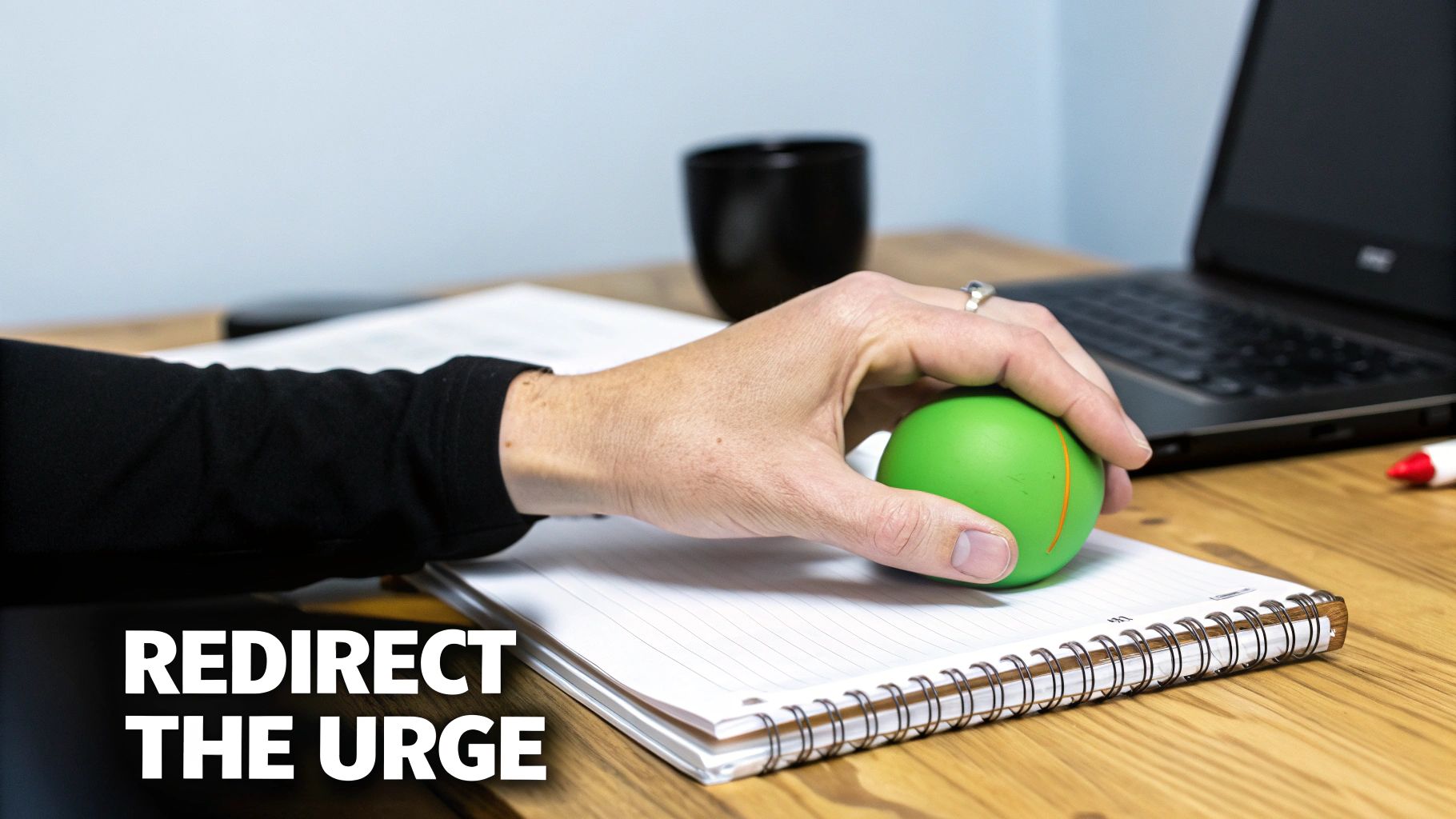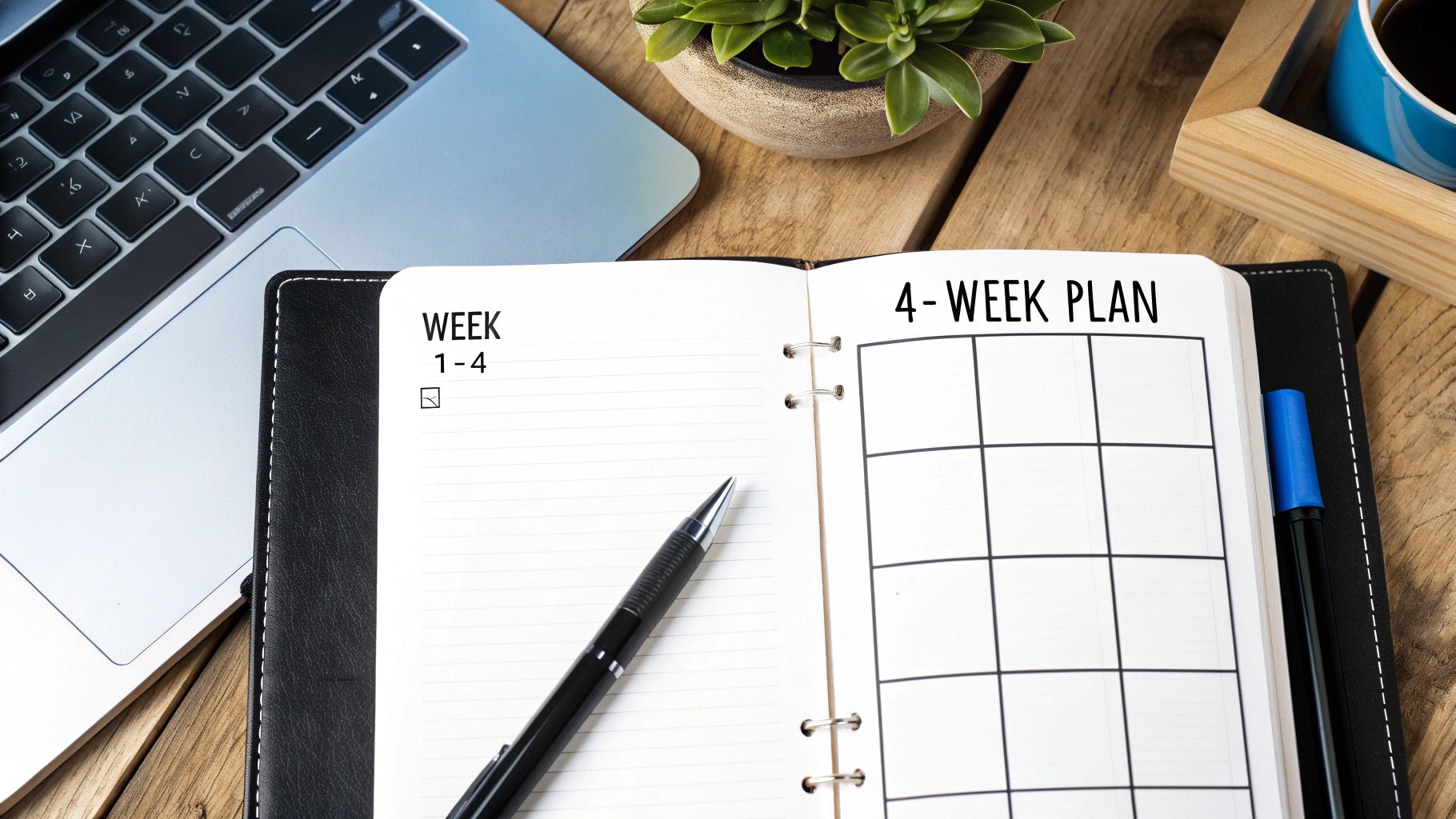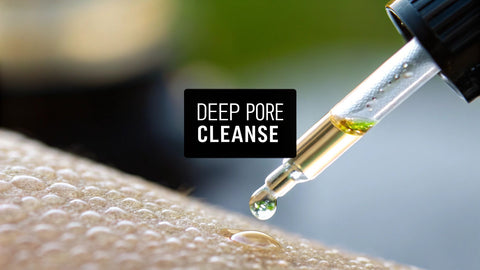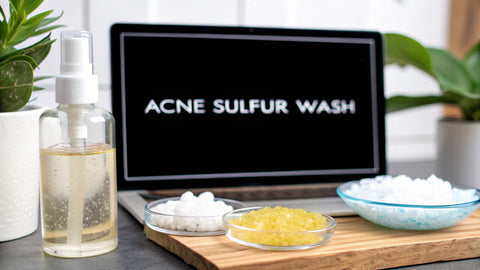How to Stop Touching Your Face for Clearer Skin

To truly stop touching your face, you need a solid game plan. It boils down to a three-part strategy: become aware of what triggers the habit, find ways to interrupt the action, and then replace it with something that doesn't harm your skin. This approach is all about breaking the unconscious cycle that so often leads to irritation, clogged pores, and full-blown breakouts.
Most of us have no idea just how often our hands wander to our faces until we actually start paying attention. It's a surprisingly common, automatic behavior.
Why Is It So Hard to Stop Touching Your Face?
Ever find yourself resting your chin in your hand while deep in thought, or rubbing your eyes during a long meeting? You're definitely not alone. This isn't just a random tick; it's usually an unconscious habit driven by a powerful psychological pattern called the "habit loop." This loop—made up of a cue, a routine, and a reward—runs on autopilot in the background of our daily lives.
And it runs a lot. Research has shown that when we're not actively thinking about it, we touch our faces anywhere from 0.5 to 3 times per minute. That can easily add up to hundreds, if not thousands, of touches a day. One study clocked people touching their T-zone (eyes, nose, mouth, and chin) nearly 69 times per hour.

Knowing those numbers might feel a bit daunting, but seeing the scale of the problem is the first real step toward fixing it.
Cracking the Code of Your Habit Loop
To dismantle the habit, you first have to understand how it's built. Think of it like a detective story where you're gathering clues about your own behavior.
For some, this goes beyond a simple bad habit and can be part of a larger pattern known as Body-Focused Repetitive Behaviors (BFRBs), which are sometimes connected to conditions like ADHD.
Understanding the cycle of your face-touching habit is the first step to breaking it. This table breaks down the common triggers, actions, and perceived rewards.
Decoding Your Face-Touching Habit Loop
| Component | Description | Common Examples for Face-Touching |
|---|---|---|
| Cue | The trigger that kicks off the automatic behavior. | Feeling stressed, bored, or tired; sitting at your desk; a tiny itch; feeling a bump on your skin. |
| Routine | The physical action you perform. | Rubbing your forehead, picking at a blemish, resting your chin in your hand, stroking your cheek. |
| Reward | The temporary satisfaction or relief you feel. | A brief distraction from an unpleasant emotion, the physical relief of a scratch, a sense of comfort or focus. |
Once you can map out your own habit loop, you've found the blueprint for breaking it.
The key takeaway is that face-touching isn't a sign of poor self-control; it's a deeply ingrained, often automatic response to various internal and external triggers.
By learning to spot your specific cues, you can start to intervene before your hand even starts its journey. That moment of awareness is everything. Every time you catch yourself, it's a chance to understand the "why" behind the action and consciously choose a different path. This simple act of noticing is your most powerful tool for change.
Building Awareness of Your Triggers
You can’t change a habit you don’t even notice you have. So, the first real step in this whole process is to drag that unconscious action out into the light. You have to become a detective of your own behavior, pinpointing the exact moments, feelings, and places that send your hands flying toward your face.
Think about your day. When do your fingers end up on your forehead or chin? For most of us, it’s during moments of deep focus, boredom, or stress. It could be while you're squinting at a complex spreadsheet, feeling the pressure in a meeting, or just zoning out during a movie. These are prime time for subconscious face-touching.
Create Your Own Trigger Map
Let's get practical. Grab a notebook or open a new note on your phone and create a simple "trigger map." The goal here isn't to judge yourself or feel bad; it's just about gathering data. For the next day or two, just make a quick note every single time you catch yourself.
So, what do you write down? Try to capture these three things:
- The Situation: Where are you and what’s going on? (e.g., "At my desk, reading a long email.")
- The Emotion: How are you feeling right then? (e.g., "Stressed," "bored," "tired," "lost in thought.")
- The Location: Where on your face did you touch? (e.g., "Rubbing my eyes," "resting my chin in my hand," "picking at a spot on my cheek.")
After just a couple of days, you'll be surprised by the patterns that jump out. Maybe you always rest your chin in your hand during that 3 PM slump. Or maybe you start scanning for bumps whenever you feel anxious. This map is your personal blueprint for breaking the habit.
The point isn't to be perfect overnight. It's about building that critical self-awareness so you can step in and interrupt the habit loop before it takes over. Every time you notice the urge, you've created a tiny window to make a different choice.
Practical Mindfulness Exercises
Once you have a decent idea of your triggers, you can start using subtle cues to bring more awareness into your day. These aren't meant to be huge, disruptive changes—just small, consistent reminders that gently pull your focus back to where your hands are.
A simple trick I love is to place a brightly colored sticky note on the corner of my computer monitor. It doesn't need to say anything; its sheer presence is a visual nudge to check in. Another great one is the 'hand-check' method. Set a silent alarm on your phone or watch to vibrate every 15-20 minutes. When it goes off, the only thing you have to do is ask yourself, "Where are my hands right now?"
This kind of mindful observation works by slowly rewiring your brain. Instead of your hands moving on autopilot, you create a split-second pause between the trigger (the cue) and the action (touching your face). That tiny pause is where you get your power back. It's your chance to decide not to do it.
Practical Ways to Interrupt and Redirect the Urge
Alright, now that you're getting a feel for your personal triggers, it’s time to build a practical toolkit to stop the habit in its tracks. The goal here isn’t to fight the impulse with sheer willpower—that’s just exhausting and rarely works long-term. Instead, we’re going to set up some simple physical and environmental roadblocks that make face-touching a little harder and give that nervous energy somewhere else to go.
The core idea is to make the unconscious conscious. Think about it like wearing a new ring or bracelet. The moment your hand moves toward your face, that unfamiliar sensation acts like a tiny alarm bell, giving you that split-second opportunity to catch yourself and pull back.

This strategy of creating a little "friction" is surprisingly effective. To really break an automatic cycle like this, you need to apply proven strategies to stop compulsions that interrupt the behavior before it even starts.
Create Physical Barriers
One of the most straightforward tactics is to literally put something in the way. This is a game-changer if you’re a subconscious picker, which can introduce a whole new world of bacteria and inflammation to your skin.
- Use Pimple Patches: A hydrocolloid patch over a blemish is a true two-for-one. It forms a physical shield that makes picking impossible, and it actively helps the spot heal faster by drawing out all the gunk.
- Wear Gloves: If you find your hands drifting to your face most while you're studying, deep in thought at work, or watching TV, try wearing a pair of thin cotton gloves for a bit. The barrier not only stops you but also makes the act feel less satisfying, snapping you out of the habit.
This isn't just a theory; it's backed by some pretty compelling real-world data. During the COVID-19 pandemic, studies found that widespread mask-wearing was incredibly effective at reducing how often people touched their faces.
It just goes to show that even a simple obstacle can powerfully disrupt a habit we don't even know we have.
Introduce a Substitution Behavior
Let’s be honest: your hands need something to do. Trying to just suppress that urge is a losing battle. A much smarter approach is to give them a new, better job. The key is finding a replacement action that’s harmless and gives you a similar sensory experience.
An eye-opening observational study revealed that the average person touches their face about 23 times per hour. That's a ton of idle hand time that needs a new purpose.
Here are a few of my favorite substitutes to keep at your desk, in your car, or in your pocket:
- Stress Ball or Fidget Toy: Squeezing a stress ball is a classic for a reason—it channels that pent-up tension and anxiety that so often leads to face-touching. Fidget spinners or cubes can also be a fantastic outlet for restless fingers.
- Smooth Stone: I love this one. Keep a small, smooth "worry stone" in your pocket. The simple act of rubbing it with your thumb can be incredibly calming and provides that tactile feedback you might be seeking when you touch your chin or cheek.
- Doodling or Knitting: Find a hobby that keeps your hands busy. Doodling in a notebook during a long meeting or taking up knitting while you watch a movie leaves very little opportunity for your hands to wander.
Ultimately, you'll find the most success by mixing and matching these tactics. By creating barriers while also giving your hands a new purpose, you start turning an unconscious reflex into a series of conscious, healthier choices.
Use Skincare to Remove the Reason You Touch
Sometimes, the urge to touch your face isn't just a nervous habit. It's a physical signal. Your skin feels itchy, a new bump is forming, or an existing breakout is inflamed and irritated. That sensation creates a powerful, almost primal, urge to touch, pick, and "fix" it.
Instead of battling this urge with willpower alone, you can dismantle it at the source. The truth is, calm and comfortable skin gives you far fewer reasons to touch it in the first place. This is where a smart skincare routine becomes one of your most powerful tools.

By getting ahead of irritation and breakouts, you effectively silence the physical triggers that compel you to touch your face.
The Power of the Right Ingredients
Think of a consistent Neutralyze routine as more than just an acne treatment—it's a proactive strategy to eliminate the physical "cues" that fuel the face-touching cycle. It works by targeting the root causes of irritation and clogged pores with proven, effective ingredients that we have expertly formulated to work in harmony.
Two of the biggest workhorses in this fight are Mandelic Acid and Salicylic Acid. At Neutralyze, we understand the science behind why this pair is so effective.
- Mandelic Acid: As experts in gentle-yet-powerful exfoliation, we selected this alpha-hydroxy acid (AHA) for its unique properties. Its larger molecular size means it penetrates the skin more slowly, minimizing irritation while still being incredibly effective. This makes it a hero for exfoliating away dullness, helping fade post-acne marks, and calming angry inflammation—a cornerstone of our treatment philosophy.
- Salicylic Acid: We harness the oil-soluble nature of this beta-hydroxy acid (BHA) to create products that go deeper. Its superpower is its ability to dive into pores and dissolve the mix of sebum and dead skin cells that leads to blackheads and pimples. This targeted action is key to our preventative approach.
When used together in our carefully balanced formulas, this duo doesn't just clear existing breakouts; it helps prevent new ones from even starting. That directly reduces the bumps, itching, and discomfort that make you want to touch your face. To see how these fit into a complete regimen, you can learn more about how to build a skincare routine that's right for you.
A well-designed skincare routine does more than clear acne. It quiets the physical 'noise'—the itching, stinging, and bumps—that constantly draws your hands to your face. By solving the source of the irritation, you remove the cue from the habit loop.
How Skincare Creates a Positive Cycle
Once you commit to a routine with effective ingredients, you kickstart a powerful positive feedback loop.
As your skin gets healthier, it feels smoother and less irritated. This naturally dials down your impulse to scan for imperfections. The less you touch, the less bacteria and dirt you introduce, which leads to even fewer breakouts. It’s a win-win.
This cycle is amplified by our multi-patented Nitrogen Boost™ Skincare Technology, which ensures these powerful ingredients are delivered effectively to calm redness and clear skin fast—often showing results in just a few days. By simply making your skin feel better, a consistent routine makes it fundamentally easier to keep your hands away.
Your 4-Week Plan for Finally Kicking the Habit
Trying to break a lifelong habit like face-touching can feel overwhelming. The secret isn't a massive, all-at-once effort; it's about taking small, smart steps that build on each other. This simple, four-week plan will guide you through the process, making it manageable and setting you up for real, lasting change.
We’ll start slow and layer in new strategies each week. The idea is to build momentum gradually, combining the mental tricks we've talked about with the real-world results of a solid skincare routine. It's about progress, not perfection.

Week 1: Become a Habit Detective
Your only job this week is to notice. That's it.
Pull out a notebook or open a note on your phone and start "trigger mapping." Pay close attention to when and where you touch your face. Is it during a boring meeting? While watching TV? When you feel a new bump? Jot it down.
Don't worry about stopping yourself yet. This week is purely about observation. The goal is to get a crystal-clear picture of your personal habit loop before you try to change a thing.
Week 2: Bring in the Barriers
Now that you know your triggers, it’s time to throw a wrench in the works. Based on your notes from week one, pick one or two simple interruption techniques to try.
- If you touch your face at your desk, put a stress ball right where your hand usually rests.
- If you find yourself picking at spots in the mirror, stick pimple patches on them.
- Wear a new bracelet or ring as a constant physical reminder to keep your hands down.
The key is not to try everything at once. Just find what works for you. Creating a simple obstacle is incredibly effective. In fact, research during the pandemic showed that proper mask-wearers had a face-touching rate of just 11.4% compared to 17.6% for non-wearers. That little barrier made a big difference. You can explore the full findings on face-touching behaviors here.
Week 3: Let Your Skincare Do the Work
This is where we go on the offensive. If you haven’t already, fully commit to your Neutralyze routine. The aim here is to remove the reason your hands are drawn to your face in the first place—the itchiness, the bumps, and the inflammation that beg for attention.
As our expertly formulated ingredients like Mandelic and Salicylic Acid start to calm and smooth your skin, the physical urge to touch, pick, and scan for new breakouts will naturally fade. This week is all about letting your products do the heavy lifting for you.
Remember: Progress isn't a straight line. You’ll have days where you touch your face more. That’s okay. The point is to notice it, reset, and move on without beating yourself up. A setback is just information, not a failure.
Week 4: Tune-Up and Refine
Step back and look at the last three weeks. What's working? Which barriers are most effective? Are there any sneaky triggers you’re still struggling with?
Now is the time to tweak your approach. Maybe the desk toy isn't cutting it, but you realize that keeping your nails short helps a lot. Or perhaps you need to be more diligent with your evening skincare to prevent new spots from popping up.
Think of this plan as a starting point. By now, you've learned a ton about your own habits. Use that knowledge to refine your strategy, combining behavioral changes with great skincare to build a powerful, lasting defense against breakouts.
Clearing Up Common Questions
Even with the best game plan, you're bound to have some questions. It’s totally normal. Let's tackle some of the most common things people wonder about when they're trying to kick the face-touching habit for good.
How Long Does This Actually Take?
Look, there’s no magic number here, but I can tell you from experience that most people start seeing a real, noticeable drop in how often they touch their face within about 3 to 4 weeks. That's if you stick with it.
The secret is being patient with yourself and consistent with the process. You'll get there faster by celebrating the small wins each day and pairing your awareness exercises with a solid skincare routine. When you use products with ingredients like Mandelic and Salicylic Acid, you're actually getting ahead of the problem. They help clear up the bumps and irritation that make you want to touch your face to begin with.
What About When I’m Asleep?
This is a tricky one because you're not in control. The best you can do is run a solid defense to minimize any potential damage overnight.
- Keep your nails short. Trim them down and keep them clean. This drastically cuts down on how much gunk can get transferred to your skin.
- Swap your pillowcases often. Aim for every two or three days. A clean surface for your face makes a huge difference.
- Protect active breakouts. A hydrocolloid pimple patch or a dab of spot treatment acts like a tiny shield. It keeps you from accidentally irritating a blemish while you toss and turn.
Think of a clean sleep setup as your secret weapon. You'd be surprised how much of an impact something as simple as a fresh pillowcase can have on preventing overnight breakouts.
Is It Ever Okay to Touch My Face? What About Skincare?
Yes, absolutely. The crucial difference here boils down to two things: intention and cleanliness.
When you mindlessly touch your face during the day, your hands have been everywhere—your phone, keyboard, door handles. You're basically giving bacteria a direct flight to your pores. Applying skincare, on the other hand, is a deliberate, clean process.
Just make sure you wash your hands thoroughly with soap for at least 20 seconds before you even think about starting your routine. That way, you know you’re helping your skin by applying beneficial treatments from your Neutralyze lineup, not hurting it by introducing new irritants.
Ready to take control and calm your skin for good? Let Neutralyze handle the physical triggers so you can focus on breaking the habit. Our science-backed formulas with Mandelic and Salicylic Acid are designed to clear breakouts and reduce the irritation that leads to touching. Explore the collection at https://www.neutralyze.com.


